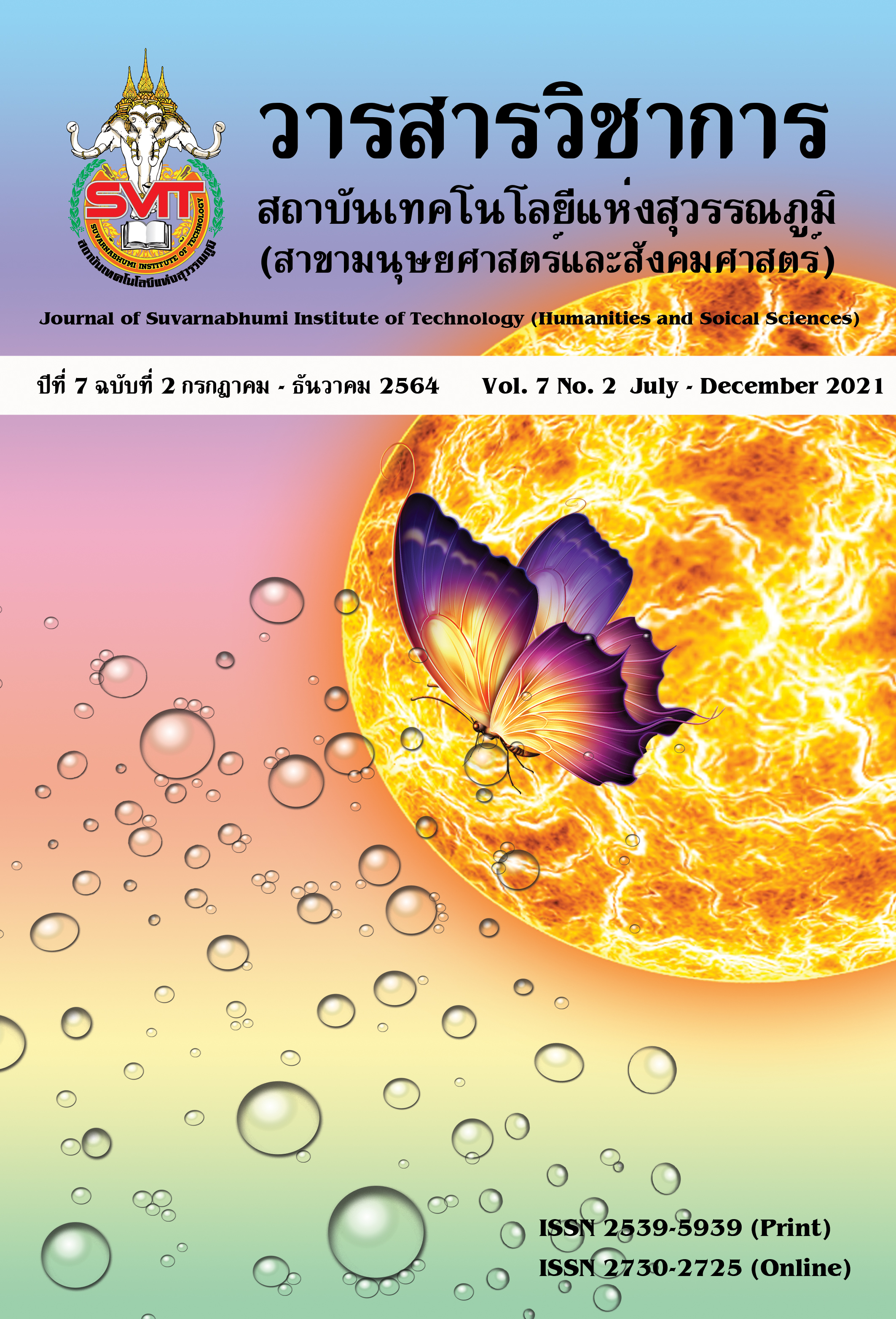พุทธภาวะในพระคัมภีร์มหายานและความเข้าใจของคณะสงฆ์จีนนิกายแห่งประเทศไทย เพื่อพัฒนามนุษย์และสังคม
คำสำคัญ:
พุทธภาวะ, พระคัมภีร์มหายาน, คณะสงฆ์จีนนิกาย, การพัฒนามนุษย์และสังคมบทคัดย่อ
งานวิจัยนี้มีวัตถุประสงค์เพื่อ 1) ศึกษาพุทธภาวะที่ปรากฏในพระคัมภีร์มหายานและวรรณกรรมที่เกี่ยวข้องในประเด็นความศรัทธา ศึกษา และปฏิบัติ 2) ศึกษาพุทธภาวะจากความรู้ความเข้าใจของพระสงฆ์มหายานจีนนิกายต่อประเด็นความศรัทธา ศึกษา และปฏิบัติ 3) ศึกษาพุทธภาวะในบริบทของการพัฒนามนุษย์และสังคม โดยดำเนินการวิจัยเอกสารและการวิจัยสนาม โดยการวิจัยเอกสารเป็นการศึกษาจากพระไตรปิฎกพากย์จีนฉบับไทโช (《大正新脩大藏經》) ปรัชญาปารมิตาสูตร มหาปรินิวาณสูตร และสัทธรรมปุณฑริกสูตร ส่วนการวิจัยสนามใช้ระเบียบวิจัยเชิงคุณภาพเก็บข้อมูลจากผู้ให้ข้อมูลสำคัญคือพระสงฆ์ในคณะสงฆ์จีนนิกายแห่งประเทศไทยจำนวน 24 รูป เพื่อวิเคราะห์เนื้อหาแล้วนำมาเขียนเชิงพรรณนา
งานวิจัยนี้ได้ข้อค้นพบการเชื่อมโยงระหว่างพุทธภาวะที่เป็นความรู้จากพระโอษฐ์ของพระพุทธเจ้า (พระไตรปิฏก) และอรรถกถาของบูรพาจารย์ กับพุทธภาวะที่เกิดจากผู้เผยแผ่หลักคำสอนพระพุทธศาสนาในปัจจุบัน (ความเข้าใจของพระสงฆ์) สามารถนำมาประยุกต์ใช้ได้กับบริบทการพัฒนามนุษย์และสังคมด้วยการให้ความสำคัญกับการสร้างคุณภาพแห่งจิตใจของคนในสังคมตามความเป็นจริงอย่างเป็นธรรมชาติ โดยบริบทการพัฒนามนุษย์คือการพัฒนาตนให้รู้ความเป็นตัวของตนเองและขจัดจิตไม่ให้ความมัวหมองของกิเลส ช่วยให้เกิดการพัฒนาจิตใจที่พร้อมช่วยเหลือผู้อื่น ในบริบทของการพัฒนาสังคมเมื่อบุคคลสามารถพัฒนาจิตใจเข้าสู่พุทธภาวะจะช่วยให้เกิดกระทำที่ดีงามในสังคมตามกาลและโอกาส ซึ่งสามารถปฏิบัติได้ในทุกชนชาติศาสนาอย่างไร้ข้อจำกัด ก่อให้เกิดรูปแบบการกระทำของสังคมที่นำมาซึ่งความสงบสุข คือโลกอันผาสุกที่ปราศจากความวุ่นวายภายในจิตใจและภายนอกจิตใจ
เอกสารอ้างอิง
ไกรฤกษ์ ศิลาคม, และศิริวรรณ เกษมศานต์กิดาการ. (2535). พุทธภาวะในทัศนะเถรวาทและมหายาน. วารสารมนุษยศาสตร์, 17(1), 118-131.
คณะสงฆ์จีนนิกายแห่งประเทศไทย. (2517). โลกพระพุทธศาสนา. ม.ป.ท.
คณะสงฆ์จีนนิกายแห่งประเทศไทย. (2536). พระพุทธศาสนามหายาน. ม.ป.ท.
คิมูระ ไทเคน. (2561). ประวัติแนวคิดมหายาน (เลียง เสถียรสุต, ผู้แปล.) (พิมพ์ครั้งที่ 4 ). นครปฐม: สำนักพิมพ์ต้นน้ำ.
จิตรกร ตั้งเกษมสุข, และธรรมเกียรติ กันอริ. (2547). คู่มือการศึกษาวิถีพุทธ: หยาดเพชร หยาดธรรมภูมิปัญญาเพื่อการศึกษาไทย. กรุงเทพมหานคร: กรมวิชาการ กระทรวงศึกษาธิการ.
ถาปกรณ์ กำเนิดศรี. (2552). มโนทัศน์เรื่องพุทธภาวะในฐานะรากฐานทางจริยธรรมในพุทธปรัชญามหายาน. (วิทยานิพนธ์ปริญญามหาบัณฑิต). มหาวิทยาลัยเกษตรศาสตร์.
นิโรธ จิตวิสุทธิ์. (2557). นิพพานฉับพลัน. กรุงเทพมหานคร: ก้าวแรก.
ประยงค์ จันทร์แดง. (2560). การศึกษาวิเคราะห์เชิงปรัชญาในมหาปรินิพพานสูตร. วารสารสันติศึกษาปริทรรศน์ มจร, 5(2), 144-158.
พระธรรมปิฎก (ป.อ. ปยุตโต). (2537). คำปราศรัยในพิธีรับรางวัลการศึกษาเพื่อสันติภาพ. ปารีส: องค์การยูเนสโก.
ยูวัล โนอาห์ แฮรารี. (2561). เซเปียนส์ ประวัติย่อมนุษยชาติ (นำชัย ชีววิวรรธน์, ผู้แปล.). กรุงเทพมหานคร: บริษัท ยิปซี กรุ๊ป จำกัด
ล.เสถียรสุต. (2551). สนทนาเรื่องนิกายเซ็น. กรุงเทพมหานคร: ไทยรายวันการพิมพ์.
สมาคมสร้างคุณค่าแห่งประเทศไทย. (2542). สัทธรรมปุณฑริกสูตร. กรุงเทพมหานคร: บริษัท สำนักพิมพ์สุภา จำกัด.
สุรพล เพชรศร. (2543). สาระสำคัญแห่งสัทธรรมปุณฑริกสูตร. กรุงเทพมหานคร: บริษัท เคล็ดไทย จำกัด.
หลวงจีนชัยภัทร (เสี่ยง้าง). (2562, 25 พฤศจิกายน). [บทสัมภาษณ์].
หลวงจีนธรรมรักษ์จีนประจิต (เย็นอี). ( 2562, 14 มีนาคม). [บทสัมภาษณ์].
หลวงจีนใบฎีกาประสิทธิ์ (เสี่ยจิ้น). (2562, 25 มกราคม). [บทสัมภาษณ์].
หลวงจีนภานุวัฒน์ (เสี่ยสก). (2561, 19 พฤศจิกายน). [บทสัมภาษณ์].
ฮวงโป. (2536). คำสอนฮวงโป (พุทธทาสภิกขุ, ผู้แปล.). กรุงเทพมหานคร.
Connected, but alone? (2012, February). TED ideas worth spreading. Retrieved from https://www.ted.com/talks/sherry_turkle_alone_together
Daisetz, S. T. (2553). ลังกาวตารสูตร (พระศรีคัมภีรณาณ (สมจินต์ สมฺมาปญฺโญ), ผู้แปล.). พระนครศรีอยุธยา: มหาจุฬาลงกรณราชวิทยาลัย.
King, S. B. (2002). From is to Ought: Natural Law in Buddhasa Bhikkhu and Phra Prayudh Payutto. The Journal of Religious Ethics, 3(2), 275-292.
SEE, T. S. H. (2016). The Doctrine of Buddha-Nature in Mahayana Buddhism. JIABU, 9(1).
周兵和李欢编. (2011). 千年菩提路一中国名寺高僧 (2). 北京: 国际文化出版公司.
大正新修大藏經刊行會. (1988). 《大正新脩大藏經》(简称《大藏經》). 東京: 大藏出版株式會社.
朱松苗和侯晓斌. (2015). 论《坛经》中“自心是佛”的思想. 五台山研究, 72-83.
释恒清. (1993). 《佛性論》之研究. 中印佛學泛論: 傅偉勳教授六十大壽祝壽論文集.
ดาวน์โหลด
เผยแพร่แล้ว
ฉบับ
ประเภทบทความ
สัญญาอนุญาต
บทความที่ได้รับการตีพิมพ์เป็นลิขสิทธิ์ของวารสารวิชาการ สถาบันเทคโนโลยีแห่งสุวรรณภูมิ
ข้อความที่ปรากฏในบทความแต่ละเรื่องในวารสารวิชาการเล่มนี้เป็นความคิดเห็นส่วนตัวของผู้เขียนแต่ละท่านไม่เกี่ยวข้องกับสถาบันเทคโนโลยีแห่งสุวรรณภูมิ และคณาจารย์ท่านอื่นๆในสถาบันฯ แต่อย่างใด ความรับผิดชอบองค์ประกอบทั้งหมดของบทความแต่ละเรื่องเป็นของผู้เขียนแต่ละท่าน หากมีความผิดพลาดใดๆ ผู้เขียนแต่ละท่านจะรับผิดชอบบทความของตนเองแต่ผู้เดียว





